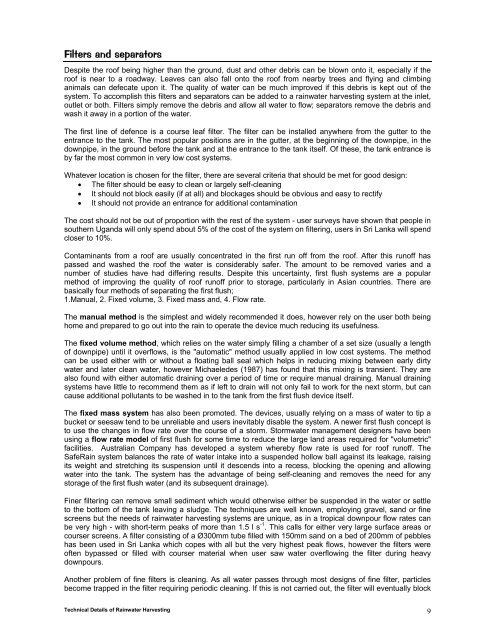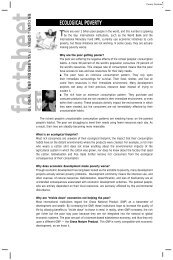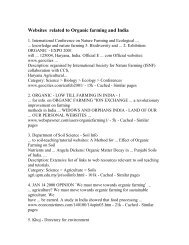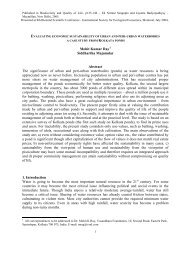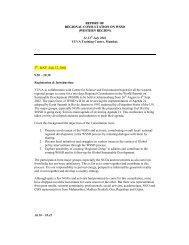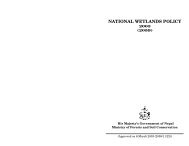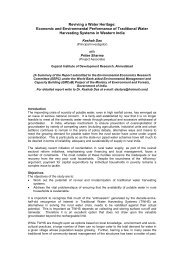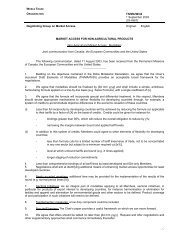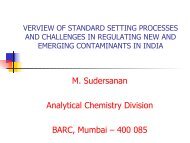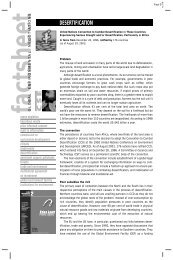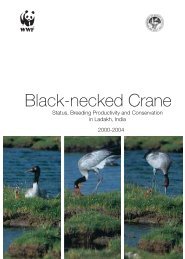Technical details - Rainwater Harvesting
Technical details - Rainwater Harvesting
Technical details - Rainwater Harvesting
Create successful ePaper yourself
Turn your PDF publications into a flip-book with our unique Google optimized e-Paper software.
Filters and separators<br />
Despite the roof being higher than the ground, dust and other debris can be blown onto it, especially if the<br />
roof is near to a roadway. Leaves can also fall onto the roof from nearby trees and flying and climbing<br />
animals can defecate upon it. The quality of water can be much improved if this debris is kept out of the<br />
system. To accomplish this filters and separators can be added to a rainwater harvesting system at the inlet,<br />
outlet or both. Filters simply remove the debris and allow all water to flow; separators remove the debris and<br />
wash it away in a portion of the water.<br />
The first line of defence is a course leaf filter. The filter can be installed anywhere from the gutter to the<br />
entrance to the tank. The most popular positions are in the gutter, at the beginning of the downpipe, in the<br />
downpipe, in the ground before the tank and at the entrance to the tank itself. Of these, the tank entrance is<br />
by far the most common in very low cost systems.<br />
Whatever location is chosen for the filter, there are several criteria that should be met for good design:<br />
• The filter should be easy to clean or largely self-cleaning<br />
• It should not block easily (if at all) and blockages should be obvious and easy to rectify<br />
• It should not provide an entrance for additional contamination<br />
The cost should not be out of proportion with the rest of the system - user surveys have shown that people in<br />
southern Uganda will only spend about 5% of the cost of the system on filtering, users in Sri Lanka will spend<br />
closer to 10%.<br />
Contaminants from a roof are usually concentrated in the first run off from the roof. After this runoff has<br />
passed and washed the roof the water is considerably safer. The amount to be removed varies and a<br />
number of studies have had differing results. Despite this uncertainty, first flush systems are a popular<br />
method of improving the quality of roof runoff prior to storage, particularly in Asian countries. There are<br />
basically four methods of separating the first flush;<br />
1.Manual, 2. Fixed volume, 3. Fixed mass and, 4. Flow rate.<br />
The manual method is the simplest and widely recommended it does, however rely on the user both being<br />
home and prepared to go out into the rain to operate the device much reducing its usefulness.<br />
The fixed volume method, which relies on the water simply filling a chamber of a set size (usually a length<br />
of downpipe) until it overflows, is the "automatic" method usually applied in low cost systems. The method<br />
can be used either with or without a floating ball seal which helps in reducing mixing between early dirty<br />
water and later clean water, however Michaeledes (1987) has found that this mixing is transient. They are<br />
also found with either automatic draining over a period of time or require manual draining. Manual draining<br />
systems have little to recommend them as if left to drain will not only fail to work for the next storm, but can<br />
cause additional pollutants to be washed in to the tank from the first flush device itself.<br />
The fixed mass system has also been promoted. The devices, usually relying on a mass of water to tip a<br />
bucket or seesaw tend to be unreliable and users inevitably disable the system. A newer first flush concept is<br />
to use the changes in flow rate over the course of a storm. Stormwater management designers have been<br />
using a flow rate model of first flush for some time to reduce the large land areas required for "volumetric"<br />
facilities. Australian Company has developed a system whereby flow rate is used for roof runoff. The<br />
SafeRain system balances the rate of water intake into a suspended hollow ball against its leakage, raising<br />
its weight and stretching its suspension until it descends into a recess, blocking the opening and allowing<br />
water into the tank. The system has the advantage of being self-cleaning and removes the need for any<br />
storage of the first flush water (and its subsequent drainage).<br />
Finer filtering can remove small sediment which would otherwise either be suspended in the water or settle<br />
to the bottom of the tank leaving a sludge. The techniques are well known, employing gravel, sand or fine<br />
screens but the needs of rainwater harvesting systems are unique, as in a tropical downpour flow rates can<br />
be very high - with short-term peaks of more than 1.5 l s -1 . This calls for either very large surface areas or<br />
courser screens. A filter consisting of a Ø300mm tube filled with 150mm sand on a bed of 200mm of pebbles<br />
has been used in Sri Lanka which copes with all but the very highest peak flows, however the filters were<br />
often bypassed or filled with courser material when user saw water overflowing the filter during heavy<br />
downpours.<br />
Another problem of fine filters is cleaning. As all water passes through most designs of fine filter, particles<br />
become trapped in the filter requiring periodic cleaning. If this is not carried out, the filter will eventually block<br />
<strong>Technical</strong> Details of <strong>Rainwater</strong> <strong>Harvesting</strong> 9


